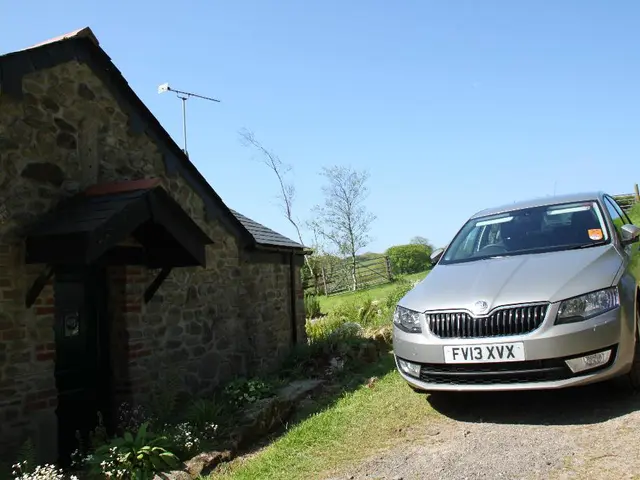A Giant Leap Forward, Now a Giant Pause: Hornsea 4's Suspension and the Offshore Wind Sector's Predicament
Orsted Abandons Hornsea 4 Wind Farm Development Due to Increasing Obstacles
The ambitious expansion of the Hornsea 4 windfarm has hit a snag, with its developer Ørsted pulling the plug. Soaring challenges, including increased costs, have dealt a significant blow to the project.
Orsted unveiled a bigger-than-anticipated surge in first-quarter profits, despite the turbulence confronting its offshore wind interests. The Danish firm successfully secured funding for both Hornsea 3 and Hornsea 4, under the government's auction of renewable energy contracts, last year.
The projects, combined, would have more than doubled the size of the existing Hornsea windfarm off the East Yorkshire coast, making it the world's largest. Boasting a potential 2,400 MW of peak capacity, it could have powered 2.6 million homes. Sadly, Ørsted announced on Wednesday that Hornsea 4 was no longer viable in its current form.
Points of concern cited by Ørsted include a succession of unfavorable developments, such as a continuous increase in supply-chain costs, higher interest rates, and an escalation in the risk to construct and operate Hornsea 4 on schedule. The firm will deliberate options for future development of the Hornsea 4 project given the continued seabed rights, grid connection agreement, and Development Consent Order.
The government's green energy objectives face a setback due to this decision. The government aims to free the UK from relying on natural gas for energy security, stating it will eradicate the country's exposure to price volatility, decrease bills, and combat climate change.
Orsted's CEO, Rasmus Errboe, affirmed their commitment to collaborating with the UK government to help achieve their ambitious offshore wind build-out targets. He added that, while they appreciate the government's efforts to establish a supportive framework for offshore wind, their capital allocation is based on a strict and value-focused approach. Consequently, they have chosen to put the development of Hornsea 4 on hold, well ahead of the planned Final Investment Decision later this year.
Energy UK's Chief Executive, Dhara Vyas, emphasized the significance of renewable energy, particularly wind power, in reducing reliance on imported fossil fuels and creating a resilient energy system. However, the loss of a project of Hornsea 4's magnitude raises the stakes for the upcoming Contracts for Difference auction round (AR7).
Meanwhile, Greenpeace UK's head of climate, Mel Evans, underscored the connection between rising energy costs and reliance on gas, which exacerbates inflation and manufacturing costs. She advocated doubling down on the commitment to clean power and investing in domestic wind manufacturing to surmount supply chain issues, lower costs, and further the government's clean power plan.
As the clean energy sector grapples with escalating project costs, higher interest rates, and rampant supply chain disruptions, governments must adapt their policies and support mechanisms to effectively navigate these tests, ensuring that the goals of a sustainable and secure energy future remain within reach.
Conversation Starters:
- The challenges faced by the offshore wind sector: costs, interest rates, and supply chain issues
- Governments' role in supporting green energy, including through auctions and Contracts for Difference
- Balancing ambitious renewable targets with the current economic and supply chain environment
Related Topics:
- Climate Change
- Wind Power
- Clean Energy Transition
- Renewable Energy Auctions
- Contracts for Difference
References:[1] "Ørsted to leave Hornsea 4 windfarm due to higher costs," BBC News. (2023, April 6). Retrieved from https://www.bbc.co.uk/news/business-65244623[2] "Orsted Scraps Plans for Hornsea 4 Offshore Wind Farm," Power Technology. (2023, April 6). https://www.power-technology.com/projects/orsted-abandons-hornsea-4-windfarm-project/[3] "Orsted Quits Hornsea 4 Windfarm Due to Higher Costs," Offshore Energy (2023, April 6). Retrieved from https://www.offshore-energy.biz/news/orsted-quits-hornsea-4-windfarm-due-to-higher-costs.[4] "Orsted Abandons Offshore Wind Project Hornsea 4 Due To Higher Costs," Renewables Now (2023, April 6). Retrieved from https://renewablestoday.net/2023/04/06/orsted-abandons-offshore-wind-project-hornsea-4-due-to-higher-costs/
- The suspension of the Hornsea 4 windfarm development, due to increased costs and other challenges, highlights the volatility in the offshore wind sector.
- The discontinuation of Hornsea 4 also raises questions about the future of renewable energy projects, given the ongoing issues with supply chain costs, higher interest rates, and construction risks.
- In the face of these challenges, the science of climate change and the need for clean energy transition require that governments and the industry prioritize cooperative efforts to address these problems.
- By pausing the development of Hornsea 4, Ørsted has emphasized the importance of a strict and value-focused approach in the finance of renewable energy projects in an uncertain environment.
- The environmental-science community must work closely with the government and the finance sector to ensure the long-term success of the renewable-energy industry, particularly in addressing the concerns of climate-change and the UK's energy independence.
- The potential repercussions of the Hornsea 4 decision on the upcoming Contracts for Difference auction round (AR7) illustrate the need for governments to continuously adapt their policies and support mechanisms to counteract the present economic and supply chain difficulties and meet the goals of a sustainable and secure energy future.









